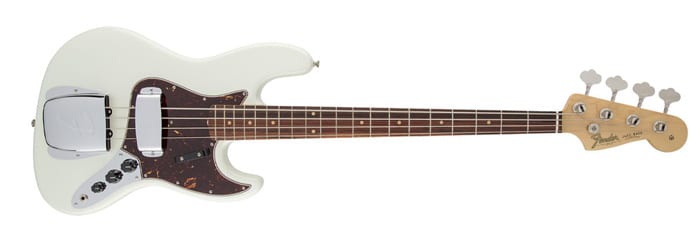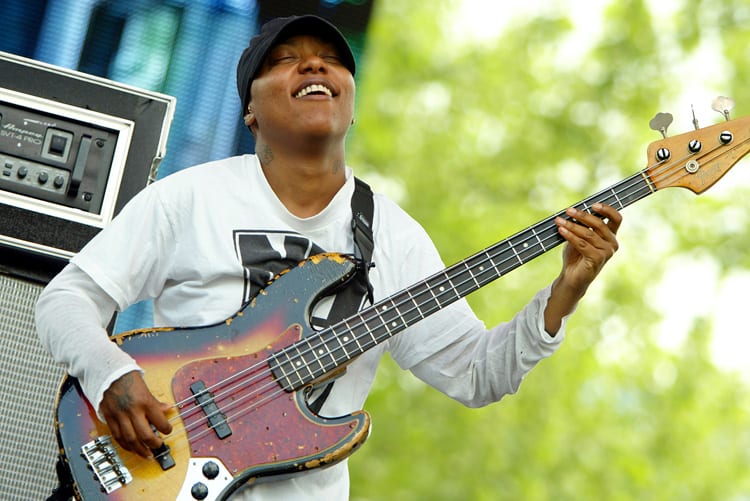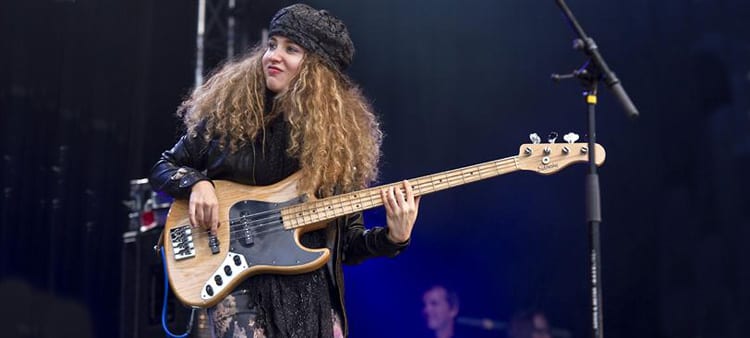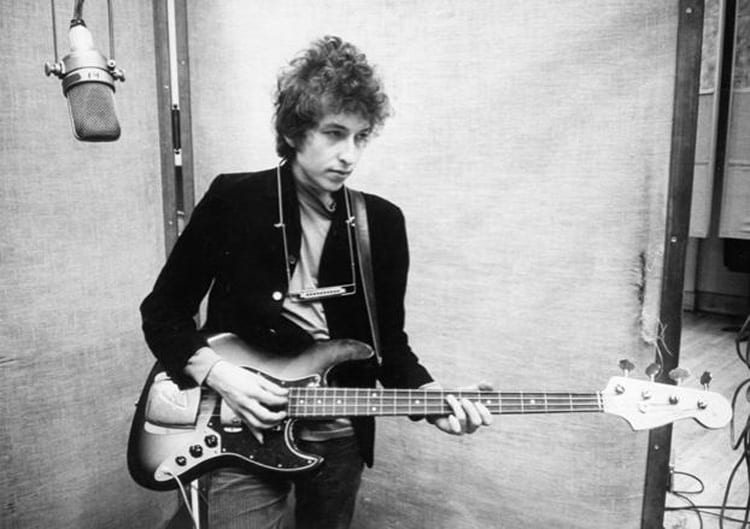Wondering how to play bass guitar? This beginner guide will teach you the fundamentals quickly. We’ll cover bass string notes, bass guitar scales, the vital importance of root notes & the only 2 arpeggio patterns you need. Let’s do it!
In this free guitar lesson you will learn:
- The role of a bass guitarist
- The all-conquering importance of root notes
- The notes of the bass guitar strings & fretboard
- The 2 essential bass guitar scales & arpeggios
- How to improvise/compose a bass line to play with a chord sequence
- 4 easy ways to sound awesome on bass guitar
Over 100,000 guitar-learners get our world-class guitar tips & tutorials sent straight to their inbox: Click here to join them
How To Play Bass Guitar: Introduction
Once upon a time there were no bass guitars.
If you wanted to be the bass player in a band, it meant lugging one of those huge upright double-basses you see in orchestras and jazz bands to and from band practice.
Then one day, the good folks at Fender saved all our backs and brought out a guitar version of the bass!
Hey presto, it became possible to learn how to play bass guitar.
There are 4 strings on a bass guitar. Each string has a name AND a number.
To learn how to play bass guitar you’ll need to know the notes of the strings. The four strings of a bass guitar are tuned the same as the lower four strings of an ordinary guitar.
- The thickest string is the 4th string. This is tuned to E. We often refer to this as the ‘low E string‘. This is the deepest/lowest bass note you can play.
- The 3rd string is tuned to A, so it’s usually referred to as the A string.
- The 2nd string is tuned to D, so it’s usually referred to as the D string.
- The thinnest string is the 1st string and it’s tuned to G, so it’s usually referred to as the G string.
These notes are the same as a standard guitar but they’re an octave lower. In layman’s terms, this means they sound deeper and lower and…. Well, bassier!
Here are all the bass guitar notes:
As you begin learning how to play bass guitar, just play the 4th string (the E string). As you progress you can start playing on the 3rd string and eventually the 2nd and 1st. But to begin with, stay on the 4th and make things easy! 🙂
To learn how to play bass guitar, you need to understand the role of the bass guitarist.
- The bass guitar in a band plays what’s called ‘the bass line’.
- Lead guitars play a lot of high up trebly stuff and rhythm guitars tend to play chords somewhere in the mid area.
- As a bass guitarist, you fill out the low end and that gives us an overall well-rounded sound.
Your job is to provide a regular and rock solid beat (along with the drummer) that provides the rhythmic foundation of a piece of music.
Some famous/notable bass guitarists are: Suzie Quatro, Kim Deal from The Pixies, Bruce Foxton from The Jam and Flea from the Red Hot Chili Peppers.
Download our lead guitar cheat-sheet to make things easier
It's hard to understand which scales work with which keys.
So we created a cheat-sheet! A key and scale-finder that you can use again and again.

Get your personalised guitar-learning plan 🎸
Get a custom guitar-learning plan here: Click here for GuitarMetrics™
World-Class Guitar Courses 🌎
Learn from the world's best guitar educators: Click here for our guitar courses
Bass guitar for beginners – getting started
The first thing you need to know as you learn how to play bass guitar is root notes.
What’s a root note? Well if the rhythm guitarist in our band tells us they’re playing a G chord, we need to match that with a G note. That’s basically what a root note is.
In this case the G root note is on the 3rd fret on the E string (the thickest string).
Let’s try giving that G note a pluck.
There’s two ways we can pluck a bass string. Either using a guitar pick or using the first two fingers of the picking hand.
If we’re using a pick, we want to use down and upstrokes to keep a nice, steady groove going on our G note. If we’re using the two fingers, we want to alternate between the two in a sort of ‘walking’ motion on the string.
The two main things to make sure of are that we’re playing the right root note for the right chord and that we’re playing it in time.
There’s lots of different rhythms we might find ourselves needing to play, but for the moment, try counting, “1 and 2 and 3 and 4 and 1 and 2 and 3 and 4 and…” and play the G note at that pace.
Be sure to keep your counting even; don’t speed up or slow down mid-count. If you want to learn how to play bass guitar, your timing has got to be impeccable.
How To Play Bass Guitar – Video 1
To learn bass guitar fast, you have to keep things simple.
Even if your dream is to play like Flea from the Red Hot Chili Peppers or Bootsy Collins from James Brown’s band, it’s best to keep things simple to start with.
Learning how to play bass guitar takes time and you can build up to doing complicated thumb-slap stuff in the future.
Remember that even the funkiest of funk bassists have to understand and appreciate the value of root notes.
Now for the next step in learning how to play bass guitar: Let’s try adding a couple more roots into the mix.
Let’s say our chord sequence is two bars of G, followed by one bar of D and one bar of A minor, playing in a continuous loop.
G | | D | Am |
The roots we need are G (3rd fret on the E string), D (5th fret on the A string) and A (5th fret on the E string). See below.
Let’s try strumming those roots at the “1 and 2 and 3 and 4 and” pace.
Here’s a video of it in action:
Remember, as a bass guitarist, you and the drummer form the core of the rhythm section of a band. With that in mind, it’s important to keep things rhythmic.
Stay on that beat: “1 and 2 and 3 and 4 and 1 and 2 and 3 and 4 and…”
So, what else can we play besides roots?
Root’s can get a bit boring after a while, especially if there’s a lot of bars of the same chord, so there are some things we can add to our bass lines to give them a bit more flavour.
It is important to remember however that roots form the foundations of our bass lines.
A bassist who plays nothing but roots, but makes sure they are the correct roots played at the correct rhythm and tempo will always beat a bassist who plays all over the fretboard with no regard for the chord sequence or song structure.
How To Play Bass Guitar: Arpeggios
‘Arpeggio’ is a rather fancy sounding word that basically means “play the notes of a chord individually”.
If you want to learn how to play bass guitar, you must master the major and minor arpeggios. Don’t worry, they are both very simple patterns.
For example, here is the G major arpeggio (one of the most common of all):
Take your time and have a few goes at this. This is a crucial pattern for a bass player to know. (You will use this again and again.)
While practising arpeggios, try to make effective use of all the fingers.
If you want to learn how to play bass guitar you have to learn to use all of those digits. Don’t just hop around using the fingers that are already strong, we need to get comfortable using all our fingers!
My advice would be to start with the middle finger on the 3rd fret note, then use the index finger for the 2nd fret and the pinky finger for the 5th fret.
Your little finger may not feel particularly strong right now, but that’s all the more reason to get using it. Build it up! 🙂
Now, once we’re confident we can play the G major arpeggio, let’s try and put it into action.
Get our best guitar tips & videos
Where should we send it?















